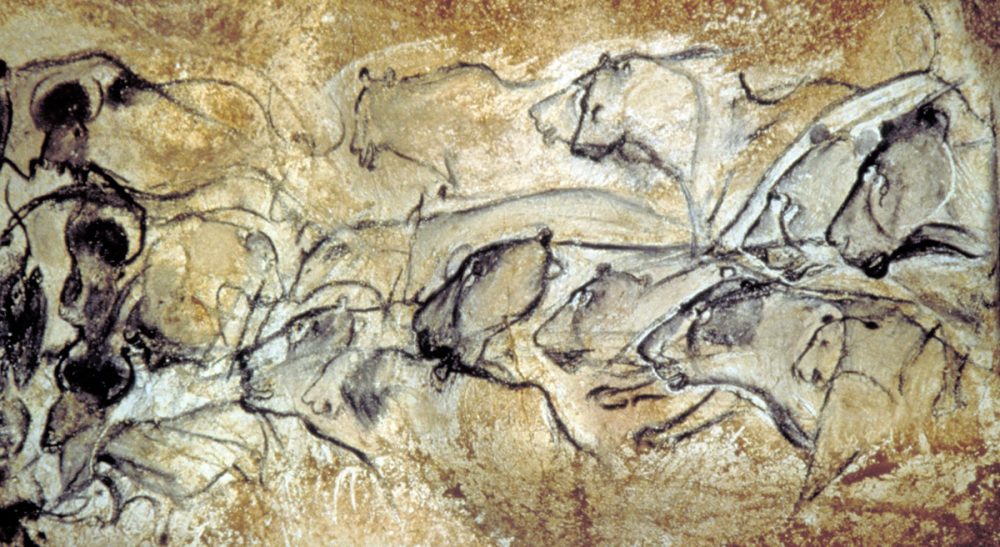Advertisement
Ancient Cave Drawings, Modern Science And The Pretense Of Preservation

Twenty years ago this month, archaeologists discovered Cave de Chauvet Pont d’Arc in southern France, with paintings more than 30,000 years old. Scientists from around the world have digitally mapped the cave, built raised walkways above its floor, and established protocols that limit access to 12 people for eight hours during two 15-day periods each year. These constraints are designed to minimize man’s effect on the site, while accommodating our human itch to explore and comprehend. We cannot know with certainty how our interactions affect a cave that was sealed for thousands of years — there’s no sister cave we can submit to double-blind testing. But I fear these safeguards are an illusion that salves our conscious while enabling us to poke around. Humans cannot simply leave something alone.
We preserve the cave floor we deem valuable, while violating other areas by erecting a walkway. We collect and analyze charcoal fragments. We chip away and stabilize, but we do not contribute, add or embellish.
Werner Herzog filmed “Cave of Forgotten Dreams” during one research cycle. The 2010 film begins with a sweeping view of Pont d’Arc, leads into the cave, and alternates between illuminating the remarkable images and describing ongoing research taking place there. By film’s end, we understand these paintings through a dual lens: as extraordinary ancestral art, and as an exquisite demonstration of our scientific ability to reconstruct the past.
Julien Monney, an archaeologist in the film, relates the story of a 1970’s Australian aborigine; a man who’s my contemporary age-wise, but the Chauvet Cave painters’ kin in his habits. When the aborigine encounters a faded rock painting, he mixes pigment and rejuvenates it. To him, the painted rock is not a fixed entity with a unique author. It’s a human contribution to the natural world that can deteriorate and be refreshed within nature’s rhythm.
Our response to the paintings at Chauvet has been exactly opposite. We preserve the cave floor we deem valuable, while violating other areas by erecting a walkway. We collect and analyze charcoal fragments. We chip away and stabilize, but we do not contribute, add or embellish.
Dominique Baffier, Curator of Chauvet Cave, explains what she considers important research findings. She attributes a pattern of red dots on a prominent rock to one specific man, six feet tall, with a distinctive thumbprint, yet determines that other paintings contain elements that span 5,000 years. To me, in 2014, such a timeframe is akin to contributing a stone to the construction of a ziggurat.
The cave paintings resemble contemporary compositions. Horses with multiple legs and a female pelvis embracing a bull’s head are Picasso and Duchamp’s spare, elegant forebears. I’ll never see them in person, and I never should. But, thanks to the digital age, I can appreciate them through Mr. Herzog’s film, 3-D mappings or the replica constructed a few miles from the cave.
Cave de Chauvet Pont d'Arc is not a cave of forgotten dreams; the cave has been found. Forgotten dreams are not accessible to our consciousness, while we’ve spent 20 years applying scientific "How?" and "What?" to scratch at the spiritual question that plagues us: "Why?"
The true cave of forgotten dreams is yet undiscovered. Once found, it will be subjected to the fashionable human proddings of that time. If Chauvet Cave had been pried open 5,000 years ago, it might have provided shelter; 500 years ago, an opportunity for plunder; five decades ago, a bonanza for tourism. Instead, the cave was found during a period fixed on preserving and replicating. We revere ancestors by freezing them in time. We co-opt them by recreating their 30,000-year-old sanctuary in three years. Are our preservation efforts a tribute to our ancestors, or do we set ourselves above them by refusing to contribute to their collective expression?
...we cannot pretend the cave away; it is found, and humans are compelled to explore. Our constant push to achieve, obtain and understand drives progress. That’s why we dominate this planet, even to the point of endangering its natural balance.
We are also left to ponder Herzog’s central question: What is time? We’ve known these paintings for less than one-one-thousandth of their existence. We determine that they’re ancient, yet consider them new because we measure existence from discovery. What is time, when more than a thousand generations lapsed between Chauvet Cave ancestors and us, yet aborigine cousins touch up similar paintings in our lifetime? Why do we care that a single man painted red dots, while other compositions evolved over millennia? Are our preservation efforts a tribute to our ancestors, or do we set ourselves above them by refusing to contribute to their collective expression?
My gut response to research in the Cave de Chauvet Pont d’Arc is to cease our meddling and seal it back up. But we cannot pretend the cave away; it is found, and humans are compelled to explore. Our constant push to achieve, obtain and understand drives progress. That’s why we dominate this planet, even to the point of endangering its natural balance.
What bothers me is our pretense of preservation. Cave de Chauvet Pont d’Arc is a phenomenal example of early man’s capabilities. Our analytical bent and technical prowess dictate that we study it rather than add our hand to it. But we’re only kidding ourselves in believing that our walkways and lasers and simple presence don’t alter this remarkable place. We make our mark by keeping our hands off, but future generations will know we were there.

